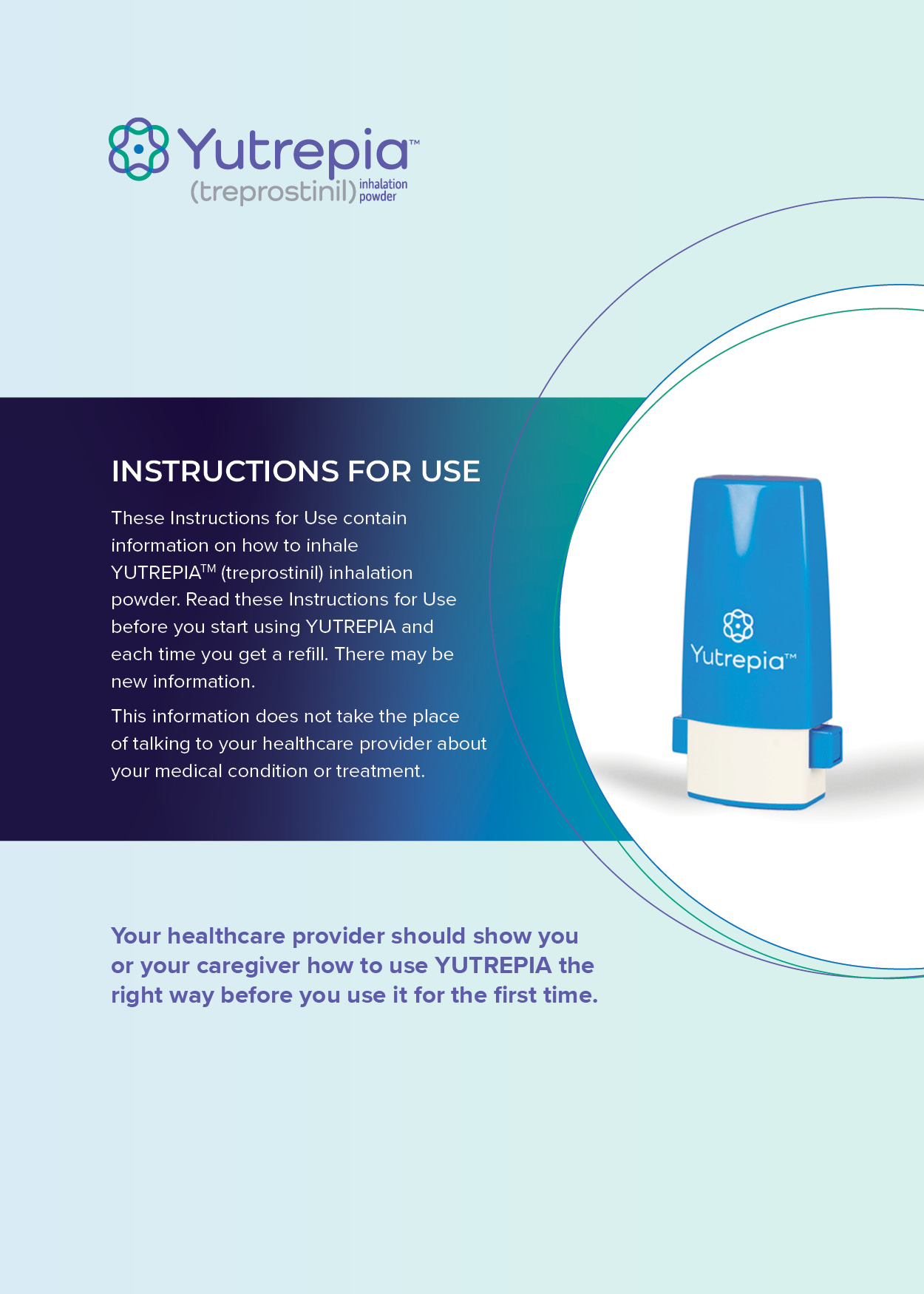Getting started:
Support and resources for your patients and your practice

THE LIQUIDIA ACCESS PROGRAM CAN HELP YOUR PATIENTS START AND STAY ON YUTREPIA
Specialty pharmacy providers can offer information to help patients determine which program might be best for them

The YUTREPIA Voucher Program
The YUTREPIA Voucher Program can provide eligible patients with a one-time, 28-day supply of YUTREPIA to help them determine if it is right for them.*
Only available for patients who are new to YUTREPIA.
The YUTREPIA Co-Pay Program
The YUTREPIA Co-Pay Program can provide financial assistance to eligible commercially insured patients.
The YUTREPIA Bridge Program
The YUTREPIA Bridge Program can provide eligible patients who cannot immediately access their prescribed medication with a one-time, 28-day supply of YUTREPIA.
The YUTREPIA Patient Assistance Program
The YUTREPIA Patient Assistance Program can provide medication at no cost to eligible patients in need of assistance affording their out-of-pocket cost for YUTREPIA.
Liquidia's patient support programs are part of its corporate social responsibility (CSR) program and are not commercial in nature. Please contact 1-888-393-5732 for more information.
YUTREPIA IS AVAILABLE THROUGH SPECIALTY PHARMACY PROVIDERS
Specialty pharmacy providers offer comprehensive patient resources
The enrollment form must be completed and faxed to one of the specialty pharmacies listed below.
The enrollment form is available here or from your YUTREPIA sales representative.
Useful resources to help with patient access and reimbursement
Upon receiving a prescription and referral to a specialty pharmacy, your patient has access to a wide range of support, including:
- Help with insurance and financial assistance options for eligible patients
- Initial delivery of YUTREPIA and educational resources
- In-home training on using YUTREPIA
- Delivery of refills to their home
- 24/7 phone support
Accredo is a registered trademark of Express Scripts Strategic Development, Inc.
CVS Specialty is a registered trademark of CVS Pharmacy, Inc.
CuraScript SD is a registered trademark of Express Scripts Strategic Development, Inc.
INDICATION AND IMPORTANT SAFETY INFORMATION
- Pulmonary arterial hypertension (PAH; WHO Group 1) to improve exercise ability. Studies establishing effectiveness predominately included patients with NYHA Functional Class III symptoms and etiologies of idiopathic or heritable PAH (56%) or PAH associated with connective tissue diseases (33%).
- Pulmonary hypertension associated with interstitial lung disease (PH-ILD; WHO Group 3) to improve exercise ability. The study establishing effectiveness predominately included patients with etiologies of idiopathic interstitial pneumonia (IIP) (45%) inclusive of idiopathic pulmonary fibrosis (IPF), combined pulmonary fibrosis and emphysema (CPFE) (25%), and WHO Group 3 connective tissue disease (22%).
WARNINGS AND PRECAUTIONS
- Treprostinil is a pulmonary and systemic vasodilator. In patients with low systemic arterial pressure, treatment with treprostinil may produce symptomatic hypotension.
- Treprostinil inhibits platelet aggregation and increases the risk of bleeding.
- Co-administration of a cytochrome P450 (CYP) 2C8 enzyme inhibitor (e.g., gemfibrozil) may increase exposure (both Cmax and AUC) to treprostinil. Co-administration of a CYP2C8 enzyme inducer (e.g., rifampin) may decrease exposure to treprostinil. Increased exposure is likely to increase adverse events associated with treprostinil administration, whereas decreased exposure is likely to reduce clinical effectiveness.
- Like other inhaled prostaglandins, YUTREPIA may cause acute bronchospasm. Patients with asthma or chronic obstructive pulmonary disease (COPD), or other bronchial hyperreactivity, are at increased risk for bronchospasm. Ensure that such patients are treated optimally for reactive airway disease prior to and during treatment with YUTREPIA.
DRUG INTERACTIONS/SPECIFIC POPULATIONS
- The concomitant use of treprostinil with diuretics, antihypertensives, or other vasodilators may increase the risk of symptomatic hypotension.
- Human pharmacokinetic studies with an oral formulation of treprostinil (treprostinil diolamine) indicated that co-administration of the cytochrome P450 (CYP) 2C8 enzyme inhibitor, gemfibrozil, increases exposure (both Cmax and AUC) to treprostinil. Co-administration of the CYP2C8 enzyme inducer, rifampin, decreases exposure to treprostinil. It is unclear if the safety and efficacy of treprostinil by the inhalation route are altered by inhibitors or inducers of CYP2C8.
- Limited case reports of treprostinil use in pregnant women are insufficient to inform a drug-associated risk of adverse developmental outcomes. However, pulmonary arterial hypertension is associated with an increased risk of maternal and fetal mortality. There are no data on the presence of treprostinil in human milk, the effects on the breastfed infant, or the effects on milk production.
- Safety and effectiveness in pediatric patients have not been established.
- Placebo-controlled clinical studies of treprostinil inhalation solution did not include sufficient numbers of patients aged 65 years and over to determine whether they respond differently from younger patients. The open label INSPIRE study in patients with PAH included 28 patients aged 65 and over in which no age-related differences were noted. In general, dose selection for an elderly patient should be cautious, reflecting the greater frequency of hepatic, renal, or cardiac dysfunction, and of concomitant diseases or other drug therapy.
- Uptitrate slowly when treating patients with hepatic insufficiency because of the risk of an increase in systemic exposure which may lead to an increase in dose-dependent adverse effects. Treprostinil has not been studied in patients with severe hepatic insufficiency.
- No dose adjustments are required in patients with renal impairment. Treprostinil is not cleared by dialysis.
ADVERSE REACTIONS
- PAH (WHO Group 1): The safety and tolerability of YUTREPIA was evaluated in an open label study (INSPIRE) of 121 patients with PAH (WHO Group 1 and NYHA Functional Class II [80 patients] and Class III [41 patients]) followed for up to 2 months. The most commonly reported adverse reactions included cough, headache, throat irritation, dizziness, which are known side effects of treprostinil inhalation solution. The adverse reactions in the INSPIRE study were consistent with those observed in previous studies of inhaled treprostinil.
- PH-ILD (WHO Group 3): In a 16-week, placebo-controlled study of 326 patients with PH-ILD (WHO Group 3), adverse reactions with inhaled treprostinil were similar to the experience in studies of PAH.
Please see Full Prescribing Information for YUTREPIA.
- Pulmonary arterial hypertension (PAH; WHO Group 1) to improve exercise ability. Studies establishing effectiveness predominately included patients with NYHA Functional Class III symptoms and etiologies of idiopathic or heritable PAH (56%) or PAH associated with connective tissue diseases (33%).
- Pulmonary hypertension associated with interstitial lung disease (PH-ILD; WHO Group 3) to improve exercise ability. The study establishing effectiveness predominately included patients with etiologies of idiopathic interstitial pneumonia (IIP) (45%) inclusive of idiopathic pulmonary fibrosis (IPF), combined pulmonary fibrosis and emphysema (CPFE) (25%), and WHO Group 3 connective tissue disease (22%).
WARNINGS AND PRECAUTIONS
- Treprostinil is a pulmonary and systemic vasodilator. In patients with low systemic arterial pressure, treatment with treprostinil may produce symptomatic hypotension.
- Treprostinil inhibits platelet aggregation and increases the risk of bleeding.
- Co-administration of a cytochrome P450 (CYP) 2C8 enzyme inhibitor (e.g., gemfibrozil) may increase exposure (both Cmax and AUC) to treprostinil. Co-administration of a CYP2C8 enzyme inducer (e.g., rifampin) may decrease exposure to treprostinil. Increased exposure is likely to increase adverse events associated with treprostinil administration, whereas decreased exposure is likely to reduce clinical effectiveness.
- Like other inhaled prostaglandins, YUTREPIA may cause acute bronchospasm. Patients with asthma or chronic obstructive pulmonary disease (COPD), or other bronchial hyperreactivity, are at increased risk for bronchospasm. Ensure that such patients are treated optimally for reactive airway disease prior to and during treatment with YUTREPIA.
DRUG INTERACTIONS/SPECIFIC POPULATIONS
- The concomitant use of treprostinil with diuretics, antihypertensives, or other vasodilators may increase the risk of symptomatic hypotension.
- Human pharmacokinetic studies with an oral formulation of treprostinil (treprostinil diolamine) indicated that co-administration of the cytochrome P450 (CYP) 2C8 enzyme inhibitor, gemfibrozil, increases exposure (both Cmax and AUC) to treprostinil. Co-administration of the CYP2C8 enzyme inducer, rifampin, decreases exposure to treprostinil. It is unclear if the safety and efficacy of treprostinil by the inhalation route are altered by inhibitors or inducers of CYP2C8.
- Limited case reports of treprostinil use in pregnant women are insufficient to inform a drug-associated risk of adverse developmental outcomes. However, pulmonary arterial hypertension is associated with an increased risk of maternal and fetal mortality. There are no data on the presence of treprostinil in human milk, the effects on the breastfed infant, or the effects on milk production.
- Safety and effectiveness in pediatric patients have not been established.
- Placebo-controlled clinical studies of treprostinil inhalation solution did not include sufficient numbers of patients aged 65 years and over to determine whether they respond differently from younger patients. The open label INSPIRE study in patients with PAH included 28 patients aged 65 and over in which no age-related differences were noted. In general, dose selection for an elderly patient should be cautious, reflecting the greater frequency of hepatic, renal, or cardiac dysfunction, and of concomitant diseases or other drug therapy.
- Uptitrate slowly when treating patients with hepatic insufficiency because of the risk of an increase in systemic exposure which may lead to an increase in dose-dependent adverse effects. Treprostinil has not been studied in patients with severe hepatic insufficiency.
- No dose adjustments are required in patients with renal impairment. Treprostinil is not cleared by dialysis.
ADVERSE REACTIONS
- PAH (WHO Group 1): The safety and tolerability of YUTREPIA was evaluated in an open label study (INSPIRE) of 121 patients with PAH (WHO Group 1 and NYHA Functional Class II [80 patients] and Class III [41 patients]) followed for up to 2 months. The most commonly reported adverse reactions included cough, headache, throat irritation, dizziness, which are known side effects of treprostinil inhalation solution. The adverse reactions in the INSPIRE study were consistent with those observed in previous studies of inhaled treprostinil.
- PH-ILD (WHO Group 3): In a 16-week, placebo-controlled study of 326 patients with PH-ILD (WHO Group 3), adverse reactions with inhaled treprostinil were similar to the experience in studies of PAH.
Please see Full Prescribing Information for YUTREPIA.




